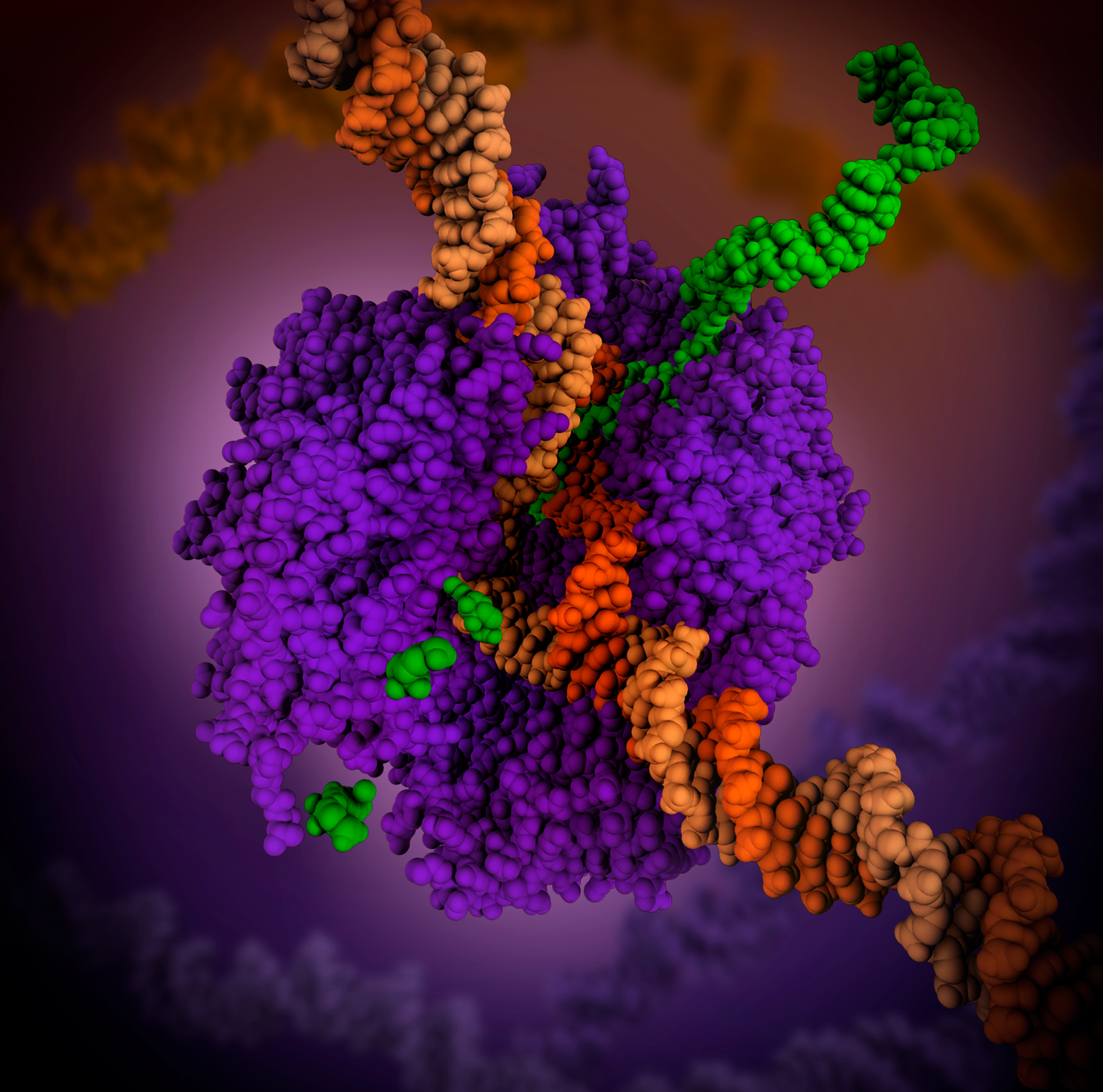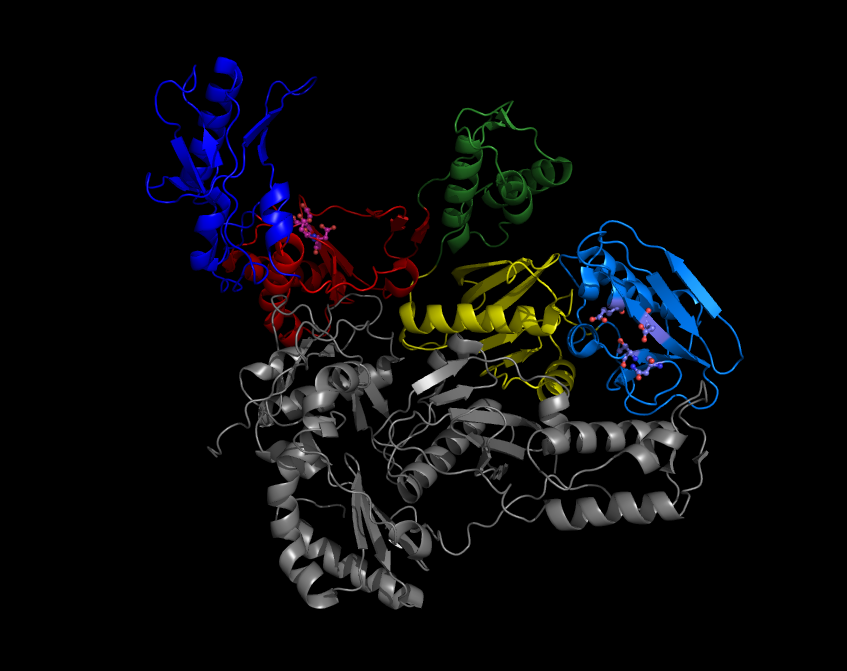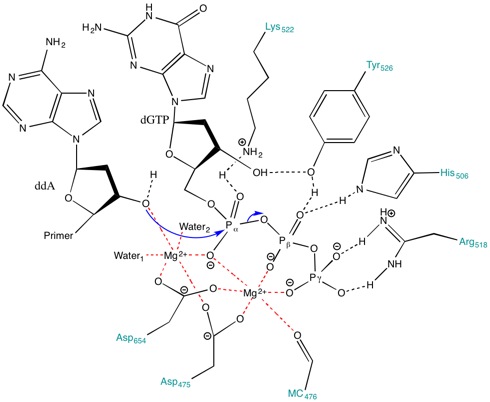|
T7 RNA Polymerase
T7 RNA Polymerase is an RNA polymerase from the T7 bacteriophage that catalyzes the formation of RNA from DNA in the 5'→ 3' direction. Activity T7 polymerase is extremely promoter-specific and transcribes only DNA downstream of a T7 promoter. The T7 polymerase also requires a double stranded DNA template and Mg2+ ion as cofactor for the synthesis of RNA. It has a very low error rate. T7 polymerase has a molecular weight of 99 kDa. Promoter The promoter is recognized for binding and initiation of the transcription. The consensus in T7 and related phages is: 5' * 3' T7 TAATACGACTCACTATAGGGAGA T3 AATTAACCCTCACTAAAGGGAGA K11 AATTAGGGCACACTATAGGGAGA SP6 ATTTACGACACACTATAGAAGAA bind------------ -----------init Transcription begins at the asterisk-marked guanine. Structure T7 polymerase has been crystallised in several forms and the structures placed in the PDB. These explain how T7 polymerase binds to DNA and trans ... [...More Info...] [...Related Items...] OR: [Wikipedia] [Google] [Baidu] |
RNA Polymerase
In molecular biology, RNA polymerase (abbreviated RNAP or RNApol), or more specifically DNA-directed/dependent RNA polymerase (DdRP), is an enzyme that catalyzes the chemical reactions that synthesize RNA from a DNA template. Using the enzyme helicase, RNAP locally opens the double-stranded DNA so that one strand of the exposed nucleotides can be used as a template for the synthesis of RNA, a process called transcription. A transcription factor and its associated transcription mediator complex must be attached to a DNA binding site called a promoter region before RNAP can initiate the DNA unwinding at that position. RNAP not only initiates RNA transcription, it also guides the nucleotides into position, facilitates attachment and elongation, has intrinsic proofreading and replacement capabilities, and termination recognition capability. In eukaryotes, RNAP can build chains as long as 2.4 million nucleotides. RNAP produces RNA that, functionally, is either for protei ... [...More Info...] [...Related Items...] OR: [Wikipedia] [Google] [Baidu] |
Rifampicin
Rifampicin, also known as rifampin, is an ansamycin antibiotic used to treat several types of bacterial infections, including tuberculosis (TB), ''Mycobacterium avium'' complex, leprosy, and Legionnaires' disease. It is almost always used together with other antibiotics with two notable exceptions: when given as a "preferred treatment that is strongly recommended" for latent TB infection; and when used as post-exposure prophylaxis to prevent ''Haemophilus influenzae'' type b and meningococcal disease in people who have been exposed to those bacteria. Before treating a person for a long period of time, measurements of liver enzymes and blood counts are recommended. Rifampicin may be given either by mouth or intravenously. Common side effects include nausea, vomiting, diarrhea, and loss of appetite. It often turns urine, sweat, and tears a red or orange color. Liver problems or allergic reactions may occur. It is part of the recommended treatment of active tuberculosis during ... [...More Info...] [...Related Items...] OR: [Wikipedia] [Google] [Baidu] |
T7 Expression System
The T7 expression system is utilized in the field of microbiology to clone recombinant DNA using strains of E. coli. It is the most popular system for expressing recombinant proteins in E. coli. By 2021, this system had been described in over 220,000 research publications. Development The sequencing and annotating of the genome of the T7 bacteriophage took place in the 1980s at the U.S. Department of Energy's Brookhaven National Laboratory, under the senior biophysicist F. William Studier. Soon, the lab was able to clone the T7 RNA polymerase and use it, along with the powerful T7 promoter, to transcribe copious amounts of almost any gene.Karen McNulty Walsh. "The Science Behind the Shot: Biotech Tools Developed at Brookhaven Lab Fundamental to Making COVID-19 Vaccines." Brookhaven National Laboratory. April 13, 2021. Accessed Oct 4 2021. The development of the T7 expression system has been considered the most successful biotechnology developed at the Brookhaven National Labo ... [...More Info...] [...Related Items...] OR: [Wikipedia] [Google] [Baidu] |
Bovine Serum Albumin
Bovine serum albumin (BSA or "Fraction V") is a serum albumin protein derived from cows. It is often used as a protein concentration standard in lab experiments. The nickname "Fraction V" refers to albumin being the fifth fraction of the original Edwin Cohn purification methodology that made use of differential solubility characteristics of plasma proteins. By manipulating solvent concentrations, pH, salt levels, and temperature, Cohn was able to pull out successive "fractions" of blood plasma. The process was first commercialized with human albumin for medical use and later adopted for production of BSA. Properties The full-length BSA precursor polypeptide is 607 amino acids (AAs) in length. An N-terminal 18-residue signal peptide is cut off from the precursor protein upon secretion, hence the initial protein product contains 589 amino acid residues. An additional six amino acids are cleaved to yield the mature BSA protein that contains 583 amino acids. BSA has thre ... [...More Info...] [...Related Items...] OR: [Wikipedia] [Google] [Baidu] |
Spermidine
Spermidine is a polyamine compound () found in ribosomes and living tissues and having various metabolic functions within organisms. Function Spermidine is an Aliphatic compound, aliphatic polyamine. Spermidine synthase (SPDS) catalyzes its formation from putrescine. It is a precursor to other polyamines, such as spermine and its structural isomer polyamine#thermospermine, thermospermine. Spermidine synchronizes an array of biological processes, (such as Ca2+, Na+, K+ -ATPase) thus maintaining membrane potential and controlling intracellular pH and volume. Spermidine regulates biological processes, such as Ca2+ influx by glutamatergic N-Methyl-D-aspartic acid, ''N''-methyl-D-aspartate receptor (NMDA receptor), which has been associated with nitric oxide synthase (NOS) and cGMP/PKG pathway activation and a decrease of Na+,K+-ATPase activity in cerebral cortex synaptosomes. Spermidine is a longevity agent in mammals due to various mechanisms of action, which are just beginning to ... [...More Info...] [...Related Items...] OR: [Wikipedia] [Google] [Baidu] |
Vector (molecular Biology)
In molecular cloning, a vector is any particle (e.g., plasmids, cosmids, Lambda phages) used as a vehicle to artificially carry a foreign nucleic acid sequence, nucleic sequence – usually DNA – into another Cell (biology), cell, where it can DNA replication, be replicated and/or Gene expression, expressed. A vector containing foreign DNA is termed recombinant DNA. The four major types of vectors are plasmids, viral vectors, cosmids, and Bacterial artificial chromosome, artificial chromosomes. Of these, the most commonly used vectors are plasmids. Common to all engineered vectors are an origin of replication, a multiple cloning site, multicloning site, and a selectable marker. The vector itself generally carries a DNA sequence that consists of an Insert (molecular biology), insert (in this case the transgene) and a larger sequence that serves as the "backbone" of the vector. The purpose of a vector which transfers genetic information to another cell is typically to isolate, mu ... [...More Info...] [...Related Items...] OR: [Wikipedia] [Google] [Baidu] |
DNA Polymerase
A DNA polymerase is a member of a family of enzymes that catalyze the synthesis of DNA molecules from nucleoside triphosphates, the molecular precursors of DNA. These enzymes are essential for DNA replication and usually work in groups to create two identical DNA duplexes from a single original DNA duplex. During this process, DNA polymerase "reads" the existing DNA strands to create two new strands that match the existing ones. These enzymes catalysis, catalyze the chemical reaction : deoxynucleoside triphosphate + DNAn pyrophosphate + DNAn+1. DNA polymerase adds nucleotides to the Directionality (molecular biology), three prime (3')-end of a DNA strand, one nucleotide at a time. Every time a Cell division, cell divides, DNA polymerases are required to duplicate the cell's DNA, so that a copy of the original DNA molecule can be passed to each daughter cell. In this way, genetic information is passed down from generation to generation. Before replication can take place, an enzy ... [...More Info...] [...Related Items...] OR: [Wikipedia] [Google] [Baidu] |
Reverse Transcriptase
A reverse transcriptase (RT) is an enzyme used to convert RNA genome to DNA, a process termed reverse transcription. Reverse transcriptases are used by viruses such as HIV and hepatitis B to replicate their genomes, by retrotransposon mobile genetic elements to proliferate within the host genome, and by eukaryotic cells to extend the telomeres at the ends of their linear chromosomes. The process does not violate the flows of genetic information as described by the classical central dogma, but rather expands it to include transfers of information from RNA to DNA. Retroviral RT has three sequential biochemical activities: RNA-dependent DNA polymerase activity, ribonuclease H (RNase H), and DNA-dependent DNA polymerase activity. Collectively, these activities enable the enzyme to convert single-stranded RNA into double-stranded cDNA. In retroviruses and retrotransposons, this cDNA can then integrate into the host genome, from which new RNA copies can be made via host-cell ... [...More Info...] [...Related Items...] OR: [Wikipedia] [Google] [Baidu] |
POLRMT
DNA-directed RNA polymerase, mitochondrial is an enzyme that in humans is encoded by the ''POLRMT'' gene. Function This gene encodes a mitochondrial DNA-directed RNA polymerase. The gene product is responsible for mitochondrial gene expression as well as for providing RNA primers for initiation of replication of the mitochondrial genome. Although this polypeptide has the same function as the three nuclear DNA-directed RNA polymerases, it is more closely related to RNA polymerases of bacteriophage (including T7 RNA polymerase), mitochondrial polymerases of lower eukaryotes as well as chloroplastic RpoT polymerases. Structure The structure of the enzyme has been solved. It exhibits an overall structure similar to that of phage RNAP, but the initiation mechanism is different in that it requires initiation factors TFAM Mitochondrial transcription factor A, abbreviated as ''TFAM'' or ''mtTFA'', is a protein that in humans is encoded by the ''TFAM'' gene. Function This gen ... [...More Info...] [...Related Items...] OR: [Wikipedia] [Google] [Baidu] |
T7 Phage
Bacteriophage T7 (or the T7 phage) is a bacteriophage, a virus that infects bacteria. It infects most strains of ''Escherichia coli'' and relies on these hosts to propagate. Bacteriophage T7 has a Lytic cycle, lytic life cycle, meaning that it destroys the cell it infects. It also possesses several properties that make it an ideal phage for experimentation: its purification and concentration have produced consistent values in chemical analyses; it can be rendered noninfectious by exposure to UV light; and it can be used in phage display to clone RNA-binding protein, RNA binding proteins. Discovery In a 1945 study by Demerec and Fano, T7 was used to describe one of the seven phage types (T1 to T7) that grow lytically on ''Escherichia coli''. Although all seven phages were numbered arbitrarily, phages with odd numbers, or T-odd phages, were later discovered to share morphological and biochemical features that distinguish them from T-even phages. Before being physically referred to ... [...More Info...] [...Related Items...] OR: [Wikipedia] [Google] [Baidu] |
T7 DNA Polymerase
T7 DNA polymerase is an enzyme used during the DNA replication of the T7 bacteriophage. During this process, the DNA polymerase “reads” existing DNA strands and creates two new strands that match the existing ones. The T7 DNA polymerase requires a host factor, ''E. coli'' thioredoxin, in order to carry out its function. This helps stabilize the binding of the necessary protein to the primer-template to improve processivity by more than 100-fold, which is a feature unique to this enzyme. It is a member of the Family A DNA polymerases, which include ''E. coli'' DNA polymerase I and Taq DNA polymerase. This polymerase has various applications in site-directed mutagenesis as well as a high-fidelity enzyme suitable for PCR. It has also served as the precursor to Sequenase, an engineered-enzyme optimized for DNA sequencing. Mechanism Phosphoryl transfer Figure 2. Nucleotidyl transfer by DNA polymerase. T7 DNA polymerase catalyzes the phosphoryl transfer during DNA replicati ... [...More Info...] [...Related Items...] OR: [Wikipedia] [Google] [Baidu] |
RNA-dependent RNA Polymerase
RNA-dependent RNA polymerase (RdRp) or RNA replicase is an enzyme that catalyzes the self-replication, replication of RNA from an RNA template. Specifically, it catalyzes synthesis of the RNA strand Complementarity (molecular biology), complementary to a given RNA template. This is in contrast to typical DNA-dependent RNA polymerases, which all organisms use to catalyze the transcription (genetics), transcription of RNA from a DNA template. RdRp is an essential protein encoded in the genomes of most RNA-containing viruses that lack a DNA stage, including SARS-CoV-2. Some eukaryotes also contain RdRps, which are involved in RNA interference and differ structurally from viral RdRps. History Viral RdRps were discovered in the early 1960s from studies on mengovirus and polio virus when it was observed that these viruses were not sensitive to actinomycin D, a drug that inhibits cellular DNA-directed RNA synthesis. This lack of sensitivity suggested the action of a virus-specific ... [...More Info...] [...Related Items...] OR: [Wikipedia] [Google] [Baidu] |





